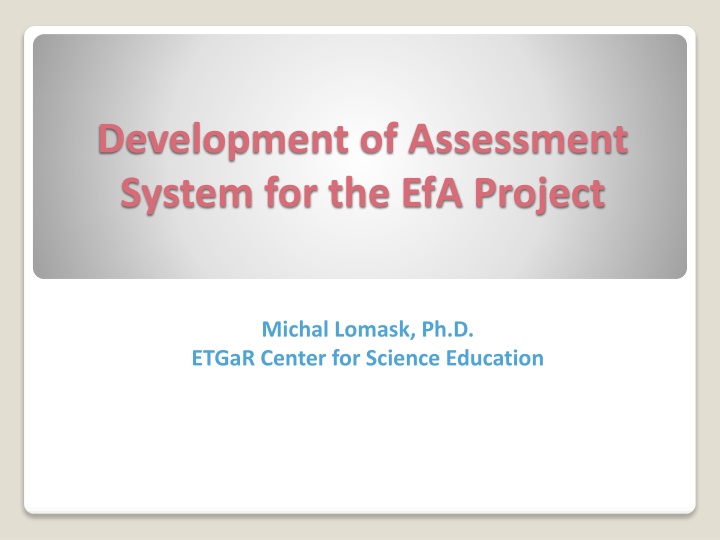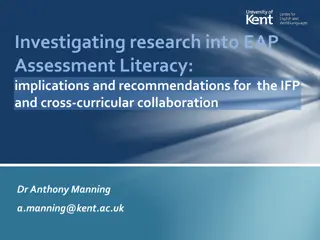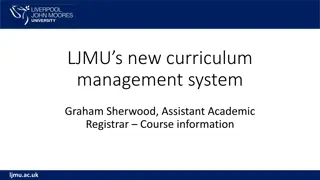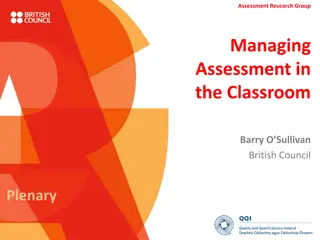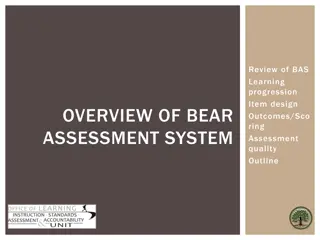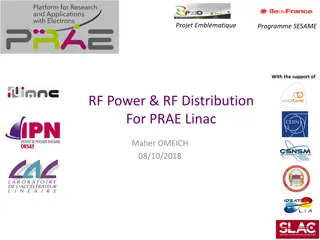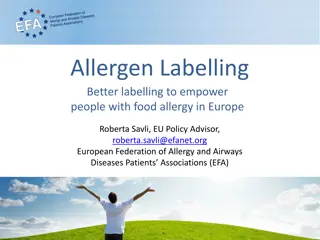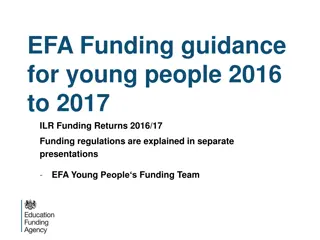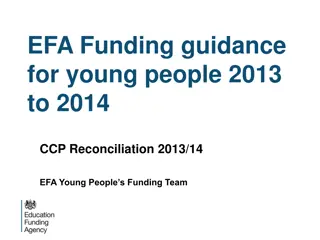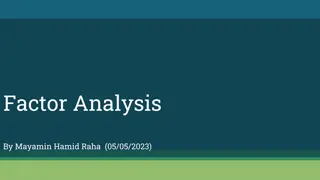Development of Assessment System for EfA Project
Assessment systems for the EfA Project should combine traditional tests with performance assessments to allow students to demonstrate their abilities in designing, problem-solving, and communication. These assessments serve both formative and summative purposes. The EfA assessments will use Evidence Centered Design to create valid and fair assessments that do not preclude any student from participating. The assessments will focus on NGSS practices of science and engineering, as well as major themes like Design, Modeling, Systems, Resources, and Human Values.
Download Presentation

Please find below an Image/Link to download the presentation.
The content on the website is provided AS IS for your information and personal use only. It may not be sold, licensed, or shared on other websites without obtaining consent from the author.If you encounter any issues during the download, it is possible that the publisher has removed the file from their server.
You are allowed to download the files provided on this website for personal or commercial use, subject to the condition that they are used lawfully. All files are the property of their respective owners.
The content on the website is provided AS IS for your information and personal use only. It may not be sold, licensed, or shared on other websites without obtaining consent from the author.
E N D
Presentation Transcript
Development of Assessment System for the EfA Project Michal Lomask, Ph.D. ETGaR Center for Science Education
Assessment systems should combine traditional "sit-down" tests with classroom-based performance assessments that allow students to demonstrate their abilities to design and conduct investigations, solve complex problems, and communicate in a variety of ways. Properly used, both assessments can serve formative as well as summative purposes. T. Conley, Linda Darling-Hammond (2013). Creating Systems Of Assessment For Deeper Learning. Stanford Center for Opportunity Policy in Education (SCOPE) and Educational Policy Improvement Center (EPIC). http://hub.mspnet.org/index.cfm/26556 ml
EFA Assessment Tasks will: Create tangible evidence of students understanding and skills Be embedded in the unit s curriculum (not stand alone) Provide students with opportunities for both showing what they know and engaging in new learning Include scoring rubrics that describe expected performance along specific knowledge dimension Provide teachers with relevant instructional information about students progress and existing learning needs ml
The EfA assessments will use Evidence Centered Design (ECD). ECD provides a framework for building valid and fair assessments. In this process, assessment developers first identify the nature of the evidence that is needed to make a judgment about specified aspects of student learning. Then, they examine any proposed assessment task to ensure that it does not preclude or reduce the opportunity for any student to participate in the task and show certain knowledge, skills, and abilities (KSAs). (Mislevy et al, 2003; Zhang et al., 2010) ml
NGSS practices of science and engineering that may be learned and assessed in the EfA units: 1. Asking questions (for science) and defining problems (for engineering) 2. Developing and using models 3. Planning and carrying out investigations 4. Analyzing and interpreting data 5. Using mathematics and computational thinking 6. Constructing explanations (for science) and designing solutions (for engineering) 7. Engaging in argument from evidence 8. Obtaining, evaluating, and communicating information ml
EfA major themes that may be learned and assessed: Design Modeling Systems Resources Human Values ml
Examples of possible performance tasks: 1. Lab experiment (a KSB) 2. Independent research (a KSB) 3. Classroom debate and position paper writing task 4. Design challenge activity 5. Exit Cards (short, open-ended questions at the end of each lesson) ml
1. Lab Activity: How to clean water from soap residuals? Task outline: Preparing Soapy Water Salting the Soapy Water Removing the Soap Testing for the Presence of Soap residuals Writing a Lab Summary Report* * Marked in red is the evidence that is going to be scored.
2. Research: How much water does your family use in a week? In the next week, measure and/or estimate the amount of water that your family is using for: Showering - Gardening - Cooking - Drinking - House and dishes cleaning Examine your family s monthly water bill: How much water did your family used for a month? Was it close to your estimation? How much was the water bill? What other costs are included in the water bill except for the price of the used water? Talk to members of your family and develop a short written report: How can our family reduce the amount of water it uses? ml
3. Class debate: Should we Use Chlorine to Disinfect our Drinking Water? Read: http://plt.org/curriculum/Secondary_Modules/Risk/Use_of_Chlo rine_as_a_Drinking_Water_Disinfectant.pdf Summarize main points from this article. Conduct an Internet search and find additional resources about the topic of water chlorination. Take a position and participate in a class discussion/debate about the pros and cons of water chlorination. Write a Letter to the Editor, describing the pros and cones of using chlorine to clean our drinking water. ml
4. Design activity: Design a prototype of filtration system that can remove the following impurities from water: Sand particles Soap residuals Bacteria Constraints: You can use the following materials . The removed impurities should be collected into a Etc. ml
Written test: Example of a post-lab test Group A carried out the following experiment. 1. We put soapy water into three separate plastic cups. 2. A different substance was added to each of the cups. 3. After waiting five minutes, the mixture in each cup was filtered. 4. We examined the precipitate (which remained in the filter paper) and the filtrate (which was in the test tube) for each mixture. ml
Group B carried out the following experiment: 1. We placed 50 mL of soapy water into three plastic cups. Group B carried out the following experiment. 2. We added 10 grams of sugar to cup 1, 10 grams of table salt to cup 2, and 10 grams of Epsom salt to cup 3. We mixed each with a plastic spoon. 3. We filtered all three mixtures. 4. We then poured the filtrate (remaining liquid) into 3 1. We placed 50 mL of soapy water into three plastic cups. 2. We added 10 grams of sugar to cup 1, 10 grams of table salt to cup 2, and 10 grams of Epsom salt to cup 3. We mixed each with a plastic spoon. 3. We filtered all three mixtures. 4. We then poured the filtrate (remaining liquid) into 3 separate test tubes, shook them and measured the height of the soap suds. separate test tubes, shook them and measured the height of the soap suds. Which group wrote a better report? Explain your answer.
Summary My assessment development leading assumption is: A curriculum-based formative assessment tasks, with relevant and clear feedback to students and teachers, will build summative success . (Michal Lomask, 2010)
Assessment development issues: Content validity has to do with the degree to which the assessment required performances are aligned with the intended learning standards and specific goals. Fairness requires that validity does not change from one student group to another based on irrelevant traits. Reliability has to do with the consistency of the assessment information and focuses mainly on scoring procedures. ml
Additional aspects of validity (Jim Peligrano, 2013) * Cognitive: The extent to which an assessment taps important forms of domain and disciplinary knowledge and skill and does so in ways that are not confounded with other aspects of cognition such as language or memory load. * Instructional: The extent to which it supports teaching practice and provides valuable and timely instructional information. * Inferential: The extent to which it reliably yields model-based information about student knowledge and skills for diagnostic ml or other purposes.
